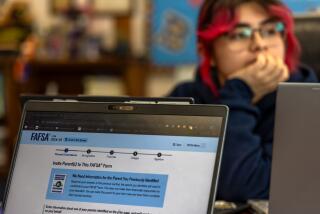The Non-Paper Chase
For the college-bound, November ushers in the season of angst as nail-biting high school seniors work into the night filling out applications for the schools of their dreams.
At least some will have one less thing to worry about this year--all that tedious paperwork.
That’s because a new way of applying--via the Internet--is moving beyond the experimental stage. Students such as Samantha Sugar of Woodland Hills are ditching the typewriter and shelving the whiteout in favor of tapping out applications on their home computers.
Sugar, 17, has already e-mailed an application to the University of Texas at Austin. And she has dialed repeatedly into the University of California’s computer, which is storing her half-finished application, protected by a secret password.
When she finishes polishing her personal essay this week, she will send it to UCLA, UC Berkeley and UC Santa Barbara--with three clicks of a button.
“It’s a lot faster and easier than doing it by hand,” Sugar said. “I think it’s catching on. Almost all of my friends are applying online too.”
Those are encouraging words to American colleges and universities, which are sinking millions of dollars into computers and software for such online applications.
The University of California, after a successful pilot project last year--open only to students at selected high schools and community colleges--made online admissions available to all applicants on Nov. 1.
UC officials hope that 10% of the usual 72,000 undergraduate applications to eight campuses will stream in via computer modem by the Nov. 30 deadline. And the initial signs are promising: So far, about 9,000 have started to cobble together applications online.
That doesn’t mean all will actually apply, of course. But it’s a good start, officials say, on easing the yearly chore of key-punching every one of the eight-page applications into university computers.
Kathleen O’Kane, UCLA’s associate director of undergraduate admissions, said online applications will be treated just like those that come through regular mail. The online applicants’ essays on, say, “the qualities and accomplishments you would bring to the undergraduate study body,” will be printed out and read alongside those typewritten--or hand-scrawled--by students applying the old-fashioned way.
The California State University, with its 22 campuses, also launched its online admissions program earlier this month--a far more ambitious project. Besides assisting students in filling out admissions and financial aid applications, it helps them pick a campus, figure out a major and select courses.
Under the Cal State online “Mentor” system, students can begin typing information about themselves and their classwork into a private database as early as their freshman year in high school. The computer will store whatever is entered over the years and offer guidance to keep each student on track for admission to Cal State, making sure, for instance, that high school studies include four years of English, three years of math and a course in visual or performing arts.
The need for such such reminders was underscored in a report this week by the California Postsecondary Education Commission showing that many students failed to complete all 15 of the courses required for Cal State eligibility.
“We wanted it to be like having an expert, or mentor, at every step of the way,” said Allen Firstenberg, president of XAP Corp., which designed the computer program for Cal State.
“If it works the way they say it will, it’s going to be terrific,” said Carolyn Barnhart, a counselor for college-bound students at Van Nuys High School. “The students will know what they need to take, what they are missing, what works and what doesn’t.”
XAP Corp. recently signed an agreement to provide the same Internet-based mentoring program for students interested in Stanford, USC, and 69 other members of the Assn. of Independent California Colleges and Universities. That program, however, will not be ready until May.
Indeed, private companies have popped up all over the World Wide Web promising either online applications to hundreds of colleges or at least application forms that can be downloaded in seconds--a godsend for those high school students who wait until the last minute to order forms.
A couple of the private companies charge a small processing fee. But mostly they make their money from colleges, and offer their Internet service free to students--though the students still must pay each college’s normal application fee.
The Web sites all promise updated information on admission criteria, classes and financial aid--information far more current than is possible with college catalogs, which are printed months before the application season.
Most also offer electronic links to campus Web pages, where students can take virtual tours, review course descriptions or browse the school’s library holdings.
*
Clearly, many students are in a position to exploit such services. According to a survey of 400 high school seniors by Arts & Science Group Inc., a marketing research firm, two-thirds had computers at home and 40% considered themselves computer proficient.
Online applications, said UC’s Terry Colvin, “are not designed for students who are intimidated by the technology. But most of these kids grew up playing Nintendo and Doom and Quake.”
Nonetheless, at least one high school guidance counselor believes that the new technology, at first, will only heighten the anxiety among top seniors this time of year.
“They are worried that they are going to send off their application,” said Glenn Ozaki, of Diamond Bar High School, “and it will disappear into cyberspace.”
UC officials insist that the system is safe, noting that they send back electronic receipts to those who file online applications.
But Bao Phan, a senior at Taft High School in Woodland Hills, is making sure the online applications she files this week reach UCLA, UC Berkeley and UC Irvine.
Instead of providing a credit card number to cover the $40 per campus application fee, she said, she will ask UC officials to bill her, so she knows the applications arrived. “I’ll also probably call and check,” she said.
(BEGIN TEXT OF INFOBOX / INFOGRAPHIC)
Pathways
Where to Apply Online
Applications to California’s public universities can be filled out at University of California’s Pathways (www.ucop.edu/pathways/) and Cal State’s Mentor (www.csumentor.edu), which also lets students track admissions requirements during high school. Collegescape (www.collegescape.com) allows students to apply to up to 50 schools, which will waive their usual application fees. Other commerical services include College Edge (www.apply.collegeedge.com), which offers an online application for seven schools in the Boston area and a common form that can be printed out for 164 others. CollegeLink (www.collegelink.com), which formats student information into different applications, and Apply Technology (www.weapply.com), which has applications to hundreds of colleges that can be printed out.
More to Read
Sign up for Essential California
The most important California stories and recommendations in your inbox every morning.
You may occasionally receive promotional content from the Los Angeles Times.










